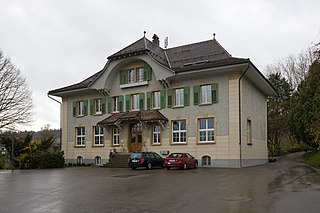Bremgarten District is a Swiss district in the Canton of Aargau, corresponding to the valleys of the Reuss and Bünz rivers in the area known as the Freiamt.
Brugg District is a district in the Canton of Aargau, Switzerland. The capital of the district is the town of Brugg.
Morges District is a district in the canton of Vaud in Switzerland. The seat of the district is the city of Morges.

Mézières is a former municipality in the district of Lavaux-Oron in the canton of Vaud in Switzerland. On 1 July 2016, the former municipalities of Mézières, Carrouge, and Ferlens merged into the new municipality of Jorat-Mézières.
Val-de-Travers District was one of the six districts of the canton of Neuchâtel, Switzerland, until the district level was eliminated on 1 January 2018. It is famous for its clock industry. The Canton is largely rural and farming remains important, but it also had significant industry from the 17th century due to the hydro-power available at St Sulpice, and Asphalt was mined from 1711 to 1986 at Travers.
Boudry District was one of the six districts of the canton of Neuchâtel, Switzerland, until the district level was eliminated on 1 January 2018. It had a population of 40,701. The district capital was the town of Boudry.
Val-de-Ruz District was one of the six districts of the canton of Neuchâtel, Switzerland, until the district level was eliminated on 1 January 2018. It consisted of the region of Val de Ruz and the surrounding Jura Mountains. The district capital was the town of Cernier. It had a population of 17,411.
Aetigkofen is a former municipality in the district of Bucheggberg in the canton of Solothurn in Switzerland. On 1 January 2014 the former municipalities of Aetigkofen, Tscheppach, Brügglen, Aetingen, Bibern (SO), Gossliwil, Hessigkofen, Mühledorf (SO), Küttigkofen, Kyburg-Buchegg merged into the new municipality of Buchegg.

Aetingen is a former municipality in the district of Bucheggberg in the canton of Solothurn in Switzerland. On 1 January 2014 the former municipalities of Aetingen, Tscheppach, Brügglen, Aetigkofen, Bibern (SO), Gossliwil, Hessigkofen, Mühledorf (SO), Küttigkofen, Kyburg-Buchegg merged into the new municipality of Buchegg.
Brügglen is a former municipality in the district of Bucheggberg, in the canton of Solothurn, Switzerland. On 1 January 2014 the former municipalities of Brügglen, Tscheppach, Aetingen, Aetigkofen, Bibern (SO), Gossliwil, Hessigkofen, Mühledorf (SO), Küttigkofen, Kyburg-Buchegg merged into the new municipality of Buchegg.

Küttigkofen is a former municipality in the district of Bucheggberg, in the canton of Solothurn, Switzerland. On 1 January 2014 the former municipalities of Küttigkofen, Tscheppach, Brügglen, Aetingen, Aetigkofen, Bibern (SO), Gossliwil, Hessigkofen, Mühledorf (SO), Kyburg-Buchegg merged into the new municipality of Buchegg.

Kyburg-Buchegg is a former municipality in the district of Bucheggberg, in the canton of Solothurn, Switzerland. On 1 January 2014 the former municipalities of Kyburg-Buchegg, Tscheppach, Brügglen, Aetingen, Aetigkofen, Bibern (SO), Gossliwil, Hessigkofen, Mühledorf (SO), Küttigkofen merged into the new municipality of Buchegg.

Nennigkofen is a former municipality in the district of Bucheggberg, in the canton of Solothurn, Switzerland. On 1 January 2013, Lüsslingen and Nennigkofen merged to form Lüsslingen-Nennigkofen.

Wasseramt District is one of the ten districts of the canton of Solothurn in Switzerland, situated to the south of the canton. Together with the Bucheggberg District, it forms the Amtei of Wasseramt-Bucheggberg. It has a population of 52,949.

Delémont District is one of the three districts of the canton of Jura, Switzerland. Its capital, and that of the canton, is the city of Delémont. The district is almost entirely French-speaking and has a population of 38,954.
See or Lac District is one of the seven districts of the canton of Fribourg in Switzerland. Lying to the north of the canton, the district is bilingual (French/German). Its territory enclaves the two Bernese municipalities of Münchenwiler and Clavaleyres, while its own village of Wallenbuch is an exclave within Bern. It has a population of 37,695.
The district of Sion is a district of the canton of Valais in Switzerland. It has a population of 48,447.
Jura-Nord Vaudois District is a district in Vaud canton of Switzerland. Its capital is Yverdon-les-Bains.
Broye-Vully District is a district in Vaud Canton in Switzerland.
Bern-Mittelland District in the Canton of Bern was created on 1 January 2010. It is part of the Bern-Mittelland administrative region, and is the only district in the region. It contains 74 municipalities with an area of 946.30 km2 (365.37 sq mi) and a population of 418,191.










